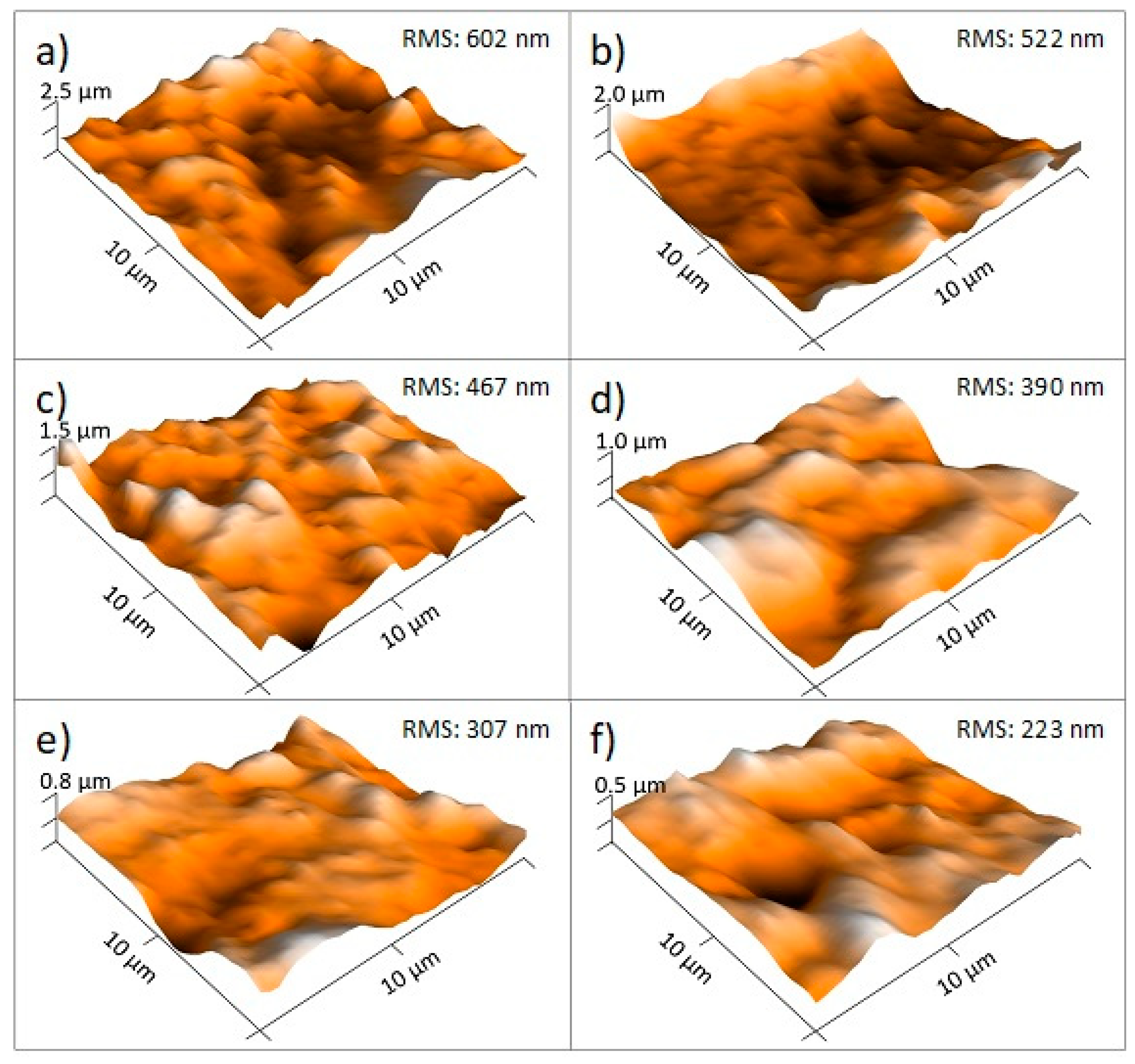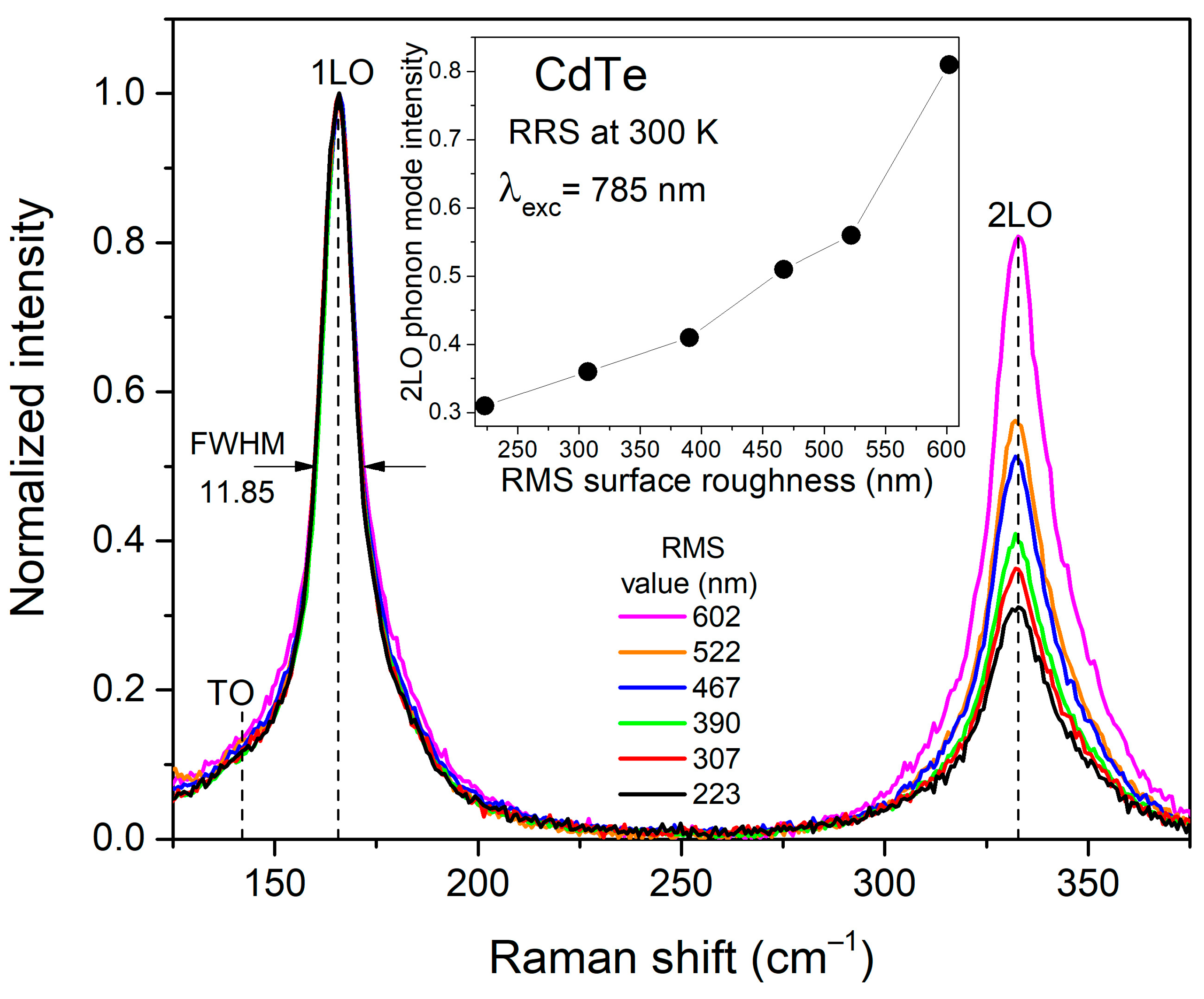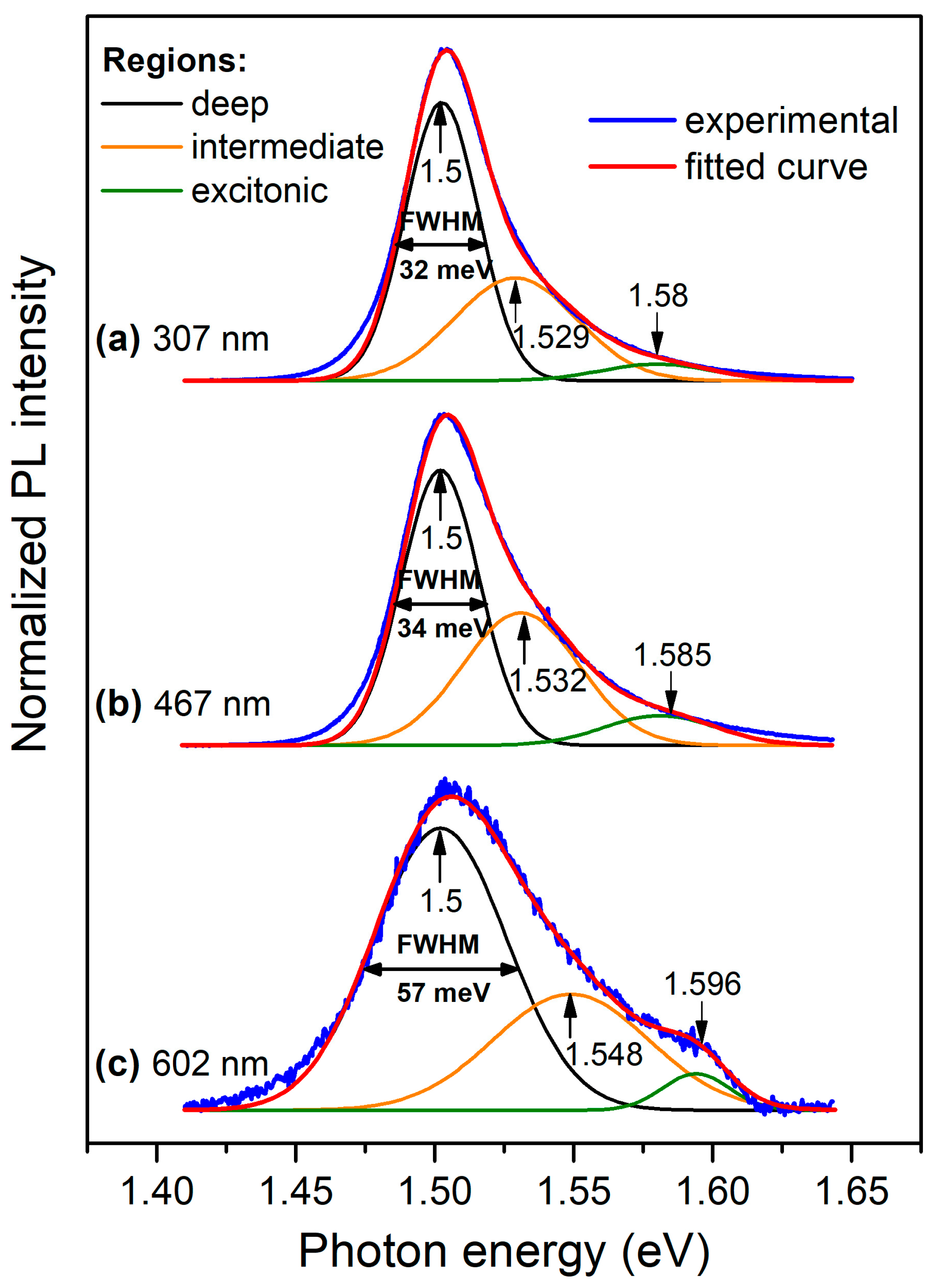Nanoscale Surface Roughness Effects on Photoluminescence and Resonant Raman Scattering of Cadmium Telluride
Abstract
:Featured Application
Abstract
1. Introduction
2. Materials and Methods
3. Results
3.1. Atomic Force Microscopy (AFM)
3.2. Photoluminescence (PL) Spectroscopy
3.3. Resonant Raman Scattering (RRS) Spectroscopy
4. Discussion
5. Conclusions
Author Contributions
Funding
Institutional Review Board Statement
Informed Consent Statement
Data Availability Statement
Acknowledgments
Conflicts of Interest
References
- Biswas, K.; Du, M.H. What causes high resistivity in CdTe. New J. Phys. 2012, 14, 063020. [Google Scholar] [CrossRef]
- Ghislotti, G.; Ielmini, G.; Riedo, E.; Martinelli, M.; Dellagiovanna, M. Picosecond time-resolved luminescence studies of recombination processes in CdTe. Solid State Commun. 1999, 111, 211–216. [Google Scholar] [CrossRef]
- Scarpulla, M.A.; McCandless, B.; Phillips, A.B.; Yan, Y.; Heben, M.J.; Wolden, C.; Xiong, G.; Metzger, W.K.; Mao, D.; Krasikov, D.; et al. CdTe-based thin film photovoltaics: Recent advances, current challenges and future prospects. Sol. Energy Mater. Sol. Cells 2023, 255, 112289. [Google Scholar] [CrossRef]
- Gnatyuk, V.; Maslyanchuk, O.; Solovan, M.; Brus, V.; Aoki, T. CdTe X/γ-ray detectors with different contact materials. Sensors 2021, 21, 3518. [Google Scholar] [CrossRef] [PubMed]
- Ahmad, N.I.; Kar, Y.B.; Doroody, C.; Kiong, T.S.; Rahman, K.S.; Harif, M.N.; Amin, N. A comprehensive review of flexible cadmium telluride solar cells with back surface field layer. Heliyon 2023, 9, e21622. [Google Scholar] [CrossRef] [PubMed]
- Hakeem, A.A.; Ali, H.M.; Abb El-Raheem, M.M.; Hasaneen, M.F. Study the effect of type of substrates on the microstructure and optical properties of CdTe thin films. Optik 2021, 225, 165390. [Google Scholar] [CrossRef]
- Campos-González, E.; de Moure-Flores, F.; Ramírez-Velázquez, L.E.; Casallas-Moreno, K.; Guillén-Cervantes, A.; Santoyo-Salazar, J.; Contreras-Puente, G.; Zelaya-Angel, O. Structural and optical properties of CdTe-nanocrystals thin films grown by chemical synthesis. Mater. Sci. Semicond. Process. 2015, 35, 144–148. [Google Scholar] [CrossRef]
- Gunjal, S.D.; Khollam, Y.B.; Jadkar, S.R.; Shripathi, T.; Sathe, V.G.; Shelke, P.N.; Takwale, M.G.; Mohite, K.C. Spray pyrolysis deposition of p-CdTe films: Structural, optical and electrical properties. Sol. Energy 2014, 106, 56–62. [Google Scholar] [CrossRef]
- Ablekim, T.; Duenow, J.N.; Zheng, X.; Moutinho, H.; Moseley, J.; Perkins, C.L.; Johnston, S.W.; O’Keefe, P.; Colegrove, E.; Albin, D.S.; et al. Thin-Film Solar Cells with 19% Efficiency by Thermal Evaporation of CdSe and CdTe. ACS Energy Lett. 2020, 5, 892–896. [Google Scholar] [CrossRef]
- Mathew, X.; Mathews, N.R.; Sebastian, P.J.; Flores, C.O. Deep levels in the band gap of CdTe films electrodeposited from an acidic bath—PICTS analysis. Sol. Energy Mater. Sol. Cells. 2004, 81, 397–405. [Google Scholar] [CrossRef]
- Lugo, J.M.; Rosendo, E.; Romano-Trujillo, R.; Oliva, A.I.; de Guevara, H.P.L.; Medel-Ruiz, C.I.; Treviño-Yarce, L.; Sarmiento Arellano, J.; Morales, C.; Díaz, T.; et al. Effects of the applied power on the properties of RF-sputtered CdTe films. Mater. Res. Express. 2019, 6, 076428. [Google Scholar] [CrossRef]
- Tang, K.; Zhu, X.; Bai, W.; Zhu, L.; Bai, J.; Dong, W.; Yang, J.; Zhang, Y.; Tang, X.; Chu, J. Molecular beam epitaxial growth and optical properties of the CdTe thin films on highly mismatched SrTiO3 substrates. J. Alloys Compd. 2016, 685, 370–375. [Google Scholar] [CrossRef]
- Krč, J.; Zeman, M.; Kluth, O.; Smole, F.; Topič, M. Effect of surface roughness of ZnO: Al films on light scattering in hydrogenated amorphous silicon solar cells. Thin Solid Films 2003, 426, 296–304. [Google Scholar] [CrossRef]
- Vyas, P.B.; Van de Put, M.L.; Fischetti, M.V. Master-equation study of quantum transport in realistic semiconductor devices including electron-phonon and surface-roughness scattering. Phys. Rev. Appl. 2020, 13, 014067. [Google Scholar] [CrossRef]
- Mori, K.; Samata, S.; Mitsugi, N.; Teramoto, A.; Kuroda, R.; Suwa, T.; Hashimoto, K.; Sugawa, S. Influence of silicon wafer surface roughness on semiconductor device characteristics. Jpn. J. Appl. Phys. 2020, 59, SMMB06. [Google Scholar] [CrossRef]
- Xie, S.; Zhu, H.; Zhang, X.; Wang, H. A brief review on the recent development of phonon engineering and manipulation at nanoscales. Int. J. Extreme Manuf. 2023, 6, 012007. [Google Scholar] [CrossRef]
- Chen, J.; Xu, K. Applications of atomic force microscopy in materials, semiconductors, polymers, and medicine: A minireview. Instrum. Sci. Technol. 2020, 48, 667–681. [Google Scholar] [CrossRef]
- Gfroerer, T.H. Photoluminescence in analysis of surfaces and interfaces. Encycl. Anal. Chem. 2000, 67, 3810. [Google Scholar] [CrossRef]
- Cannas, M.; Vaccaro, L. Time-Resolved Photoluminescence. In Spectroscopy for Materials Characterization, 1st ed.; Agnello, S., Ed.; John Wiley & Sons: Hoboken, NJ, USA, 2021; Volume 3, pp. 35–58. [Google Scholar]
- Kuciauskas, D.; Kanevce, A.; Dippo, P.; Seyedmohammadi, S.; Malik, R. Minority-carrier lifetime and surface recombination velocity in single-crystal CdTe. IEEE J. Photovolt. 2015, 5, 366–371. [Google Scholar] [CrossRef]
- Jones, R.R.; Hooper, D.C.; Zhang, L.; Wolverson, D.; Valev, V.K. Raman Techniques: Fundamentals and Frontiers. Discov. Nano 2019, 14, 231. [Google Scholar] [CrossRef]
- Schmitt, M.; Popp, J. Raman spectroscopy at the beginning of the twenty-first century. J. Raman Spectrosc. 2006, 37, 20–28. [Google Scholar] [CrossRef]
- Kusch, P.; Grelich, E.; Somaschini, C.; Luna, E.; Ramsteiner, M.; Geelhaar, L.; Riechert, H.; Reich, S. Type-II band alignment of zinc-blende and wurtzite segments in GaAs nanowires: A combined photoluminescence and resonant Raman scattering study. Phys. Rev. B 2014, 89, 045310. [Google Scholar] [CrossRef]
- Sathya, B.; Benny Anburaj, D.; Porkalai, V.; Nedunchezhian, G. Raman scattering and photoluminescence properties of Ag doped ZnO nano particles synthesized by sol–gel method. J. Mater. Sci. Mater. Electron. 2017, 28, 6022–6032. [Google Scholar] [CrossRef]
- Fonthal, G.; Tirado-Mejía, L.; Marín-Hurtado, J.I.; Ariza-Calderón, H.; Mendoza-Álvarez, J.G. Temperature dependence of the band gap energy of crystalline CdTe. J. Phys. Chem. Solids. 2000, 61, 579–583. [Google Scholar] [CrossRef]
- Akin, N.; Ozen, Y.; Efkere, H.I.; Cakmak, M.; Ozcelik, S. Surface structure and photoluminescence properties of AZO thin films on polymer substrates. Surf. Interface Anal. 2015, 47, 93–98. [Google Scholar] [CrossRef]
- Li, X.; Liu, D.; Wang, D. Anharmonic phonon decay in polycrystalline CdTe thin film. Appl. Phys. Lett. 2018, 112, 252105. [Google Scholar] [CrossRef]
- Liu, D.; Chen, J.; Wang, D.; Wu, L.; Wang, D. Enhanced surface optical phonon in CdTe thin film observed by Raman scattering. Appl. Phys. Lett. 2018, 113, 061604. [Google Scholar] [CrossRef]
- Prasad, N.; Karthikeyan, B. Resonant and Off-Resonant Phonon Properties of Wurtzite ZnS: Effect of Morphology on Fröhlich Coupling and Phonon Lifetime. J. Phys. Chem. C. 2018, 122, 18117–18123. [Google Scholar] [CrossRef]
- Musiienko, A.; Grill, R.; Hlídek, P.; Moravec, P.; Belas, E.; Zázvorka, J.; Korcsmáros, G.; Franc, J.; Vasylchenko, I. Deep levels in high resistive CdTe and CdZnTe explored by photo-Hall effect and photoluminescence spectroscopy. Semicond. Sci. Technol. 2016, 32, 015002. [Google Scholar] [CrossRef]
- Feng, Z.C.; Li, Q.; Wan, L.; Xu, G. Variation of phonon coupling factors in the photoluminescence of cadmium telluride by variable excitation power. Opt. Mater. Express 2017, 7, 808–816. [Google Scholar] [CrossRef]
- Reese, M.O.; Perkins, C.L.; Burst, J.M.; Farrell, S.; Barnes, T.M.; Johnston, S.W.; Kuclauskas, D.; Gesser, T.A.; Metzger, W.K. Intrinsic surface passivation of CdTe. J. Appl. Phys. 2015, 118, 155305. [Google Scholar] [CrossRef]
- Jovanovic, S.M.; Devenyi, G.A.; Jarvis, V.M.; Meinander, K.; Haapamaki, C.M.; Kuyanov, P.; Gerber, M.; LaPierre, R.R.; Preston, J.S. Optical characterization of epitaxial single crystal CdTe thin films on Al2O3 (0001) substrates. Thin Solid Films 2014, 570, 155–158. [Google Scholar] [CrossRef]
- Kuciauskas, D.; Krasikov, D. Spectroscopic and microscopic defect and carrier-lifetime analysis in cadmium telluride. IEEE J. Photovolt. 2018, 8, 1754–1760. [Google Scholar] [CrossRef]
- Kuciauskas, D.; Moseley, J.; Lee, C. Identification of Recombination Losses in CdSe/CdTe Solar Cells from Spectroscopic and Microscopic Time-Resolved Photoluminescence. Sol. RRL 2021, 5, 2000775. [Google Scholar] [CrossRef]
- Paul, S.; Swartz, C.; Sohal, S.; Grice, C.; Bista, S.S.; Li, D.B.; Yan, Y.; Holtz, M.; Li, J.V. Buffer/absorber interface recombination reduction and improvement of back-contact barrier height in CdTe solar cells. Thin Solid Films 2019, 685, 385–392. [Google Scholar] [CrossRef]
- Flores-Mendoza, M.A.; Castanedo-Pérez, R.; Torres-Delgado, G.; Cruz-Orea, A.; Mendoza-Alvarez, J.G.; Zelaya-Angel, O. Surface Recombination Velocity Dependence on Morphological Properties of CdTe Thin Films Prepared by Close-Spaced Sublimation. Int. J. Thermophys. 2013, 34, 1746–1753. [Google Scholar] [CrossRef]
- Amirtharaj, P.M.; Pollak, F.H. Raman scattering study of the properties and removal of excess Te on CdTe surfaces. Appl. Phys. Lett. 1984, 45, 789–791. [Google Scholar] [CrossRef]





| Phonon Mode | Peak Position (cm−1) | FWHM (cm−1) | Intensity |
|---|---|---|---|
| TO | 141 | 14 | 0.05 |
| SO | 151 | 16 | 0.035 |
| 1LO | 165.7 | 11.8 | 0.955 |
| 2LO−SO | 180.5 | 20 | 0.095 |
| 1LO+SO | 313 | 20 | 0.05 |
| 2LO | 332.5 | 18 | 0.95 |
| 3LO−SO | 348 | 20 | 0.12 |
Disclaimer/Publisher’s Note: The statements, opinions and data contained in all publications are solely those of the individual author(s) and contributor(s) and not of MDPI and/or the editor(s). MDPI and/or the editor(s) disclaim responsibility for any injury to people or property resulting from any ideas, methods, instructions or products referred to in the content. |
© 2024 by the authors. Licensee MDPI, Basel, Switzerland. This article is an open access article distributed under the terms and conditions of the Creative Commons Attribution (CC BY) license (https://creativecommons.org/licenses/by/4.0/).
Share and Cite
Medel-Ruiz, C.I.; Chiu, R.; Sevilla-Escoboza, J.R.; Casillas-Rodríguez, F.J. Nanoscale Surface Roughness Effects on Photoluminescence and Resonant Raman Scattering of Cadmium Telluride. Appl. Sci. 2024, 14, 7680. https://doi.org/10.3390/app14177680
Medel-Ruiz CI, Chiu R, Sevilla-Escoboza JR, Casillas-Rodríguez FJ. Nanoscale Surface Roughness Effects on Photoluminescence and Resonant Raman Scattering of Cadmium Telluride. Applied Sciences. 2024; 14(17):7680. https://doi.org/10.3390/app14177680
Chicago/Turabian StyleMedel-Ruiz, Carlos Israel, Roger Chiu, Jesús Ricardo Sevilla-Escoboza, and Francisco Javier Casillas-Rodríguez. 2024. "Nanoscale Surface Roughness Effects on Photoluminescence and Resonant Raman Scattering of Cadmium Telluride" Applied Sciences 14, no. 17: 7680. https://doi.org/10.3390/app14177680





